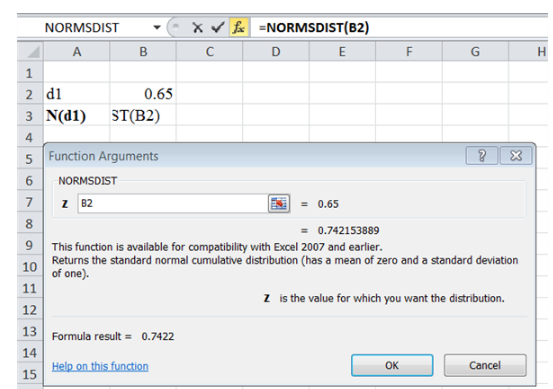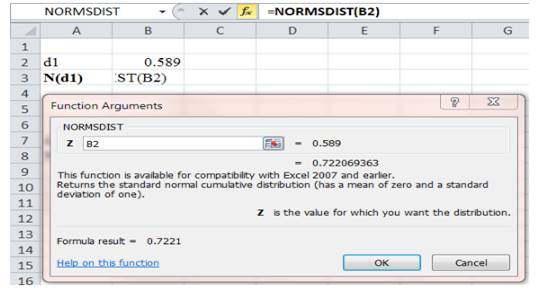
(A)
Adequate Information:
The
To calculate:
The fraction of the portfolio, fraction in equity and the stock portfolio if falls by 3%.
Introduction:
Portfolio involves financial asset grouping viz. currencies, commodities, bonds, stocks and cash equivalents. It also comprises of fund counterparts such as closed funds, exchange traded funds and mutual funds. Non-publicly tradable securities such as private, art and real estate investment are also part of portfolios.
Explanation of Solution
Fractions of portfolio invested in T-bills and equity can be calculated based on the Black-Scholes
model. The value of
to T-bills and equity can be known for value of
Formula for
Substitute values to calculate
Calculate the Black-Scholes hedge ratio

"NORMSDIST" function are as follows:
- First, go to the Menu bar of Excel and select 'Formulas' option
- Select Insert Function '(fx)
- Then select a category as Financial
- Then select "NORMSDIST" and click OK
- Then the Function Argument window will open. Now, input the given data in the required field
- Click OK
- The formula will display the final answer as 0.7422
Therefore,
Calculate the put delte as follows:
Hence, place 25.785 of the portfolio in T-bills and 74.22%
Hence, place 25.785 of the portfolio in T-bills and 74.22%
(B)
Adequate information:
To calculate:
Fractions of portfolio divided into bills and equity If stock prices fall by 3% on the first day of trading. It means
Introduction:
Portfolio involves financial asset grouping viz. currencies, commodities, bonds, stocks and cash equivalents. It also comprises of fund counterparts such as closed funds, exchange traded funds and mutual funds. Non-publicly tradable securities such as private, art and real estate investment are also part of portfolios.
Explanation of Solution
Fractions of portfolio invested in T-bills and equity can be calculated based on the Black-Scoles model. The value of
Substitute values to calculate
Calculate the Black-Scholes hedge ratio

Hence,
Calculate the put delta as follows:
Hence, place 27.79% of the portfolio in T-bills and 72.21%
Want to see more full solutions like this?
Chapter 16 Solutions
Essentials Of Investments
- Which of the following would be expected to hold its value best during a time of inflation? A certificate of deposit. A corporate bond. A house.arrow_forwardWhat is a budget? A spending plan showing sources and uses of income. A limit on spending that cannot be exceeded. The amount of money that a credit card will let youarrow_forwardThe Pan American Bottling Co. is considering the purchase of a new machine that would increase the speed of bottling and save money. The net cost of this machine is $60,000. The annual cash flows have the following projections: Year 1 ........... 2 ........... 3 ........... 4 ........... 5 ........... Cash Flow $23,000 26,000 29,000 15,000 8,000 a. If the cost of capital is 13 percent, what is the net present value of selecting a new machine? I need to see the work. I can't use Excel to solve the problem. Excel doesn't help me solve Part a.arrow_forward
- Pat and Chris have identical interest-bearing bank accounts that pay them $15 interest per year. Pat leaves the $15 in the account each year, while Chris takes the $15 home to a jar and never spends any of it. After five years, who has more money? Pat. Chris. They both have the same amount. Don’t knowarrow_forwardAssume a firm has earnings before depreciation and taxes of $200,000 and no depreciation. It is in a 25 percent tax bracket. a. Compute its cash flow using the following format: Earnings before depreciation and taxes _____Depreciation _____Earnings before taxes _____Taxes @ 25% _____Earnings after taxes _____Depreciation _____Cash Flow _____ b. Compute the cash flow for the company if depreciation is $200,000. Earnings before depreciation and taxes _____Depreciation _____Earnings before taxes _____Taxes @ 25% _____Earnings after taxes _____Depreciation _____Cash Flow _____ c. How large a cash flow benefit did the depreciation provide?arrow_forwardAssume a $40,000 investment and the following cash flows for two alternatives. Year Investment X Investment Y 1 $6,000 $15,000 2 8,000 20,000 3 9,000 10,000 4 17,000 — 5 20,000 — Which of the alternatives would you select under the payback method?arrow_forward
- The Short-Line Railroad is considering a $140,000 investment in either of two companies. The cashflows are as follows:Year Electric Co. Water Works1.................. $85,000 $30,0002.................. 25,000 25,0003.................. 30,000 85,0004–10............ 10,000 10,000a. Using the payback method, what will the decision be?b. Using the Net Present Value method, which is the better project? The discount rate is 10%.arrow_forwardWhat is corporate finance explain its important?arrow_forwardWhat is corporate finance? can you explain more?arrow_forward
- General accounting problem.arrow_forwardWhat do you know about corporate finance? tell me about thisarrow_forwardWhich of the following is the primary function of insurance? Making risk disappear. Pooling and sharing risk among the insured. Making someone else pay for an accident or loss. Don’t know.arrow_forward
 Essentials Of InvestmentsFinanceISBN:9781260013924Author:Bodie, Zvi, Kane, Alex, MARCUS, Alan J.Publisher:Mcgraw-hill Education,
Essentials Of InvestmentsFinanceISBN:9781260013924Author:Bodie, Zvi, Kane, Alex, MARCUS, Alan J.Publisher:Mcgraw-hill Education,

 Foundations Of FinanceFinanceISBN:9780134897264Author:KEOWN, Arthur J., Martin, John D., PETTY, J. WilliamPublisher:Pearson,
Foundations Of FinanceFinanceISBN:9780134897264Author:KEOWN, Arthur J., Martin, John D., PETTY, J. WilliamPublisher:Pearson, Fundamentals of Financial Management (MindTap Cou...FinanceISBN:9781337395250Author:Eugene F. Brigham, Joel F. HoustonPublisher:Cengage Learning
Fundamentals of Financial Management (MindTap Cou...FinanceISBN:9781337395250Author:Eugene F. Brigham, Joel F. HoustonPublisher:Cengage Learning Corporate Finance (The Mcgraw-hill/Irwin Series i...FinanceISBN:9780077861759Author:Stephen A. Ross Franco Modigliani Professor of Financial Economics Professor, Randolph W Westerfield Robert R. Dockson Deans Chair in Bus. Admin., Jeffrey Jaffe, Bradford D Jordan ProfessorPublisher:McGraw-Hill Education
Corporate Finance (The Mcgraw-hill/Irwin Series i...FinanceISBN:9780077861759Author:Stephen A. Ross Franco Modigliani Professor of Financial Economics Professor, Randolph W Westerfield Robert R. Dockson Deans Chair in Bus. Admin., Jeffrey Jaffe, Bradford D Jordan ProfessorPublisher:McGraw-Hill Education





